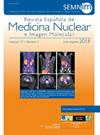Respuesta, complicaciones y riesgo de transformación leucémica del tratamiento con fósforo-32 en los síndromes mieloproliferativos crónicos Philadelphia negativos
IF 1.6
4区 医学
Q3 RADIOLOGY, NUCLEAR MEDICINE & MEDICAL IMAGING
Revista Espanola De Medicina Nuclear E Imagen Molecular
Pub Date : 2025-01-01
DOI:10.1016/j.remn.2024.500064
引用次数: 0
Abstract
Objective
Describe our experience in treatment with Phosphorus-32 (32P) for refractory Philadelphia negative chronic myeloproliferative syndromes or with side effects to the usual treatment, its complications and risk of leukemic transformation.
Material and methods
Retrospective descriptive study including 17 patients with a diagnosis of Philadelphia-negative chronic myeloproliferative syndrome treated with 32P in our hospital from January 1985 to March 2017. Indications, response to treatment, as well as early and late complications have been analyzed.
Results
Of the 17 patients treated with 32P (11 men, 6 women; mean age 79.8 years), 6 patients had polycythemia vera and 11 essential thrombocytosis. A single dose was administered in 9 of the subjects, the rest required 2 or more doses due to inadequate hematological response and/or relapse. The total dose range of 32P administered was 116-951 MBq (median: 236 MBq). In 14 patients treated with 32P, complete or partial response was achieved in hematimetry. In 11 patients, the response was complete, established as a platelet count < 400.000/mm3 in those diagnosed with essential thrombocythemia and a hematocrit < 45% in cases of polycythemia vera. The median follow-up of patients from the date of the first treatment of 32P until study completion or death was 37 months (range: 5-230 months). Regarding early complications, 2 cases of anemia requiring blood transfusion were observed, and one case of mild thrombocytopenia. No leukemic transformation was identified.
Conclusions
In our experience, treatment with 32P has been a useful therapeutic option in Philadelphia-negative chronic myeloproliferative syndromes in elderly patients who showed poor tolerance and/or resistance to first-line treatment. No leukemic transformation was identified.
费城阴性慢性骨髓增生综合征中磷-32治疗白血病转化的反应、并发症和风险
目的介绍磷-32 (32P)治疗难治性费城阴性慢性骨髓增生性综合征或对常规治疗有副作用的患者的经验、并发症及白血病转化的风险。材料与方法回顾性描述性研究,纳入我院1985年1月至2017年3月诊断为费城阴性慢性骨髓增生性综合征的患者17例。分析了适应症、治疗反应以及早期和晚期并发症。结果17例32P治疗患者(男11例,女6例;平均年龄79.8岁),真性红细胞增多症6例,原发性血小板增多症11例。其中9名受试者接受单剂量治疗,其余受试者因血液学反应不足和/或复发需要2次或更多剂量。32P给药总剂量范围为116-951 MBq(中位数:236 MBq)。在接受32P治疗的14例患者中,血液学达到完全或部分缓解。在11例患者中,反应是完全的,通过血小板计数<;诊断为原发性血小板增多症和红细胞压积/ lt者为400.000/mm3;真性红细胞增多症45%。患者从32P首次治疗之日起至研究完成或死亡的中位随访时间为37个月(范围:5-230个月)。早期并发症:贫血需输血2例,轻度血小板减少1例。未发现白血病转化。根据我们的经验,32P治疗对一线治疗耐受性和/或耐药性差的费城阴性慢性骨髓增生性综合征老年患者是一种有用的治疗选择。未发现白血病转化。
本文章由计算机程序翻译,如有差异,请以英文原文为准。
求助全文
约1分钟内获得全文
求助全文
来源期刊

Revista Espanola De Medicina Nuclear E Imagen Molecular
RADIOLOGY, NUCLEAR MEDICINE & MEDICAL IMAGING-
CiteScore
1.10
自引率
16.70%
发文量
85
审稿时长
24 days
期刊介绍:
The Revista Española de Medicina Nuclear e Imagen Molecular (Spanish Journal of Nuclear Medicine and Molecular Imaging), was founded in 1982, and is the official journal of the Spanish Society of Nuclear Medicine and Molecular Imaging, which has more than 700 members.
The Journal, which publishes 6 regular issues per year, has the promotion of research and continuing education in all fields of Nuclear Medicine as its main aim. For this, its principal sections are Originals, Clinical Notes, Images of Interest, and Special Collaboration articles.
 求助内容:
求助内容: 应助结果提醒方式:
应助结果提醒方式:


